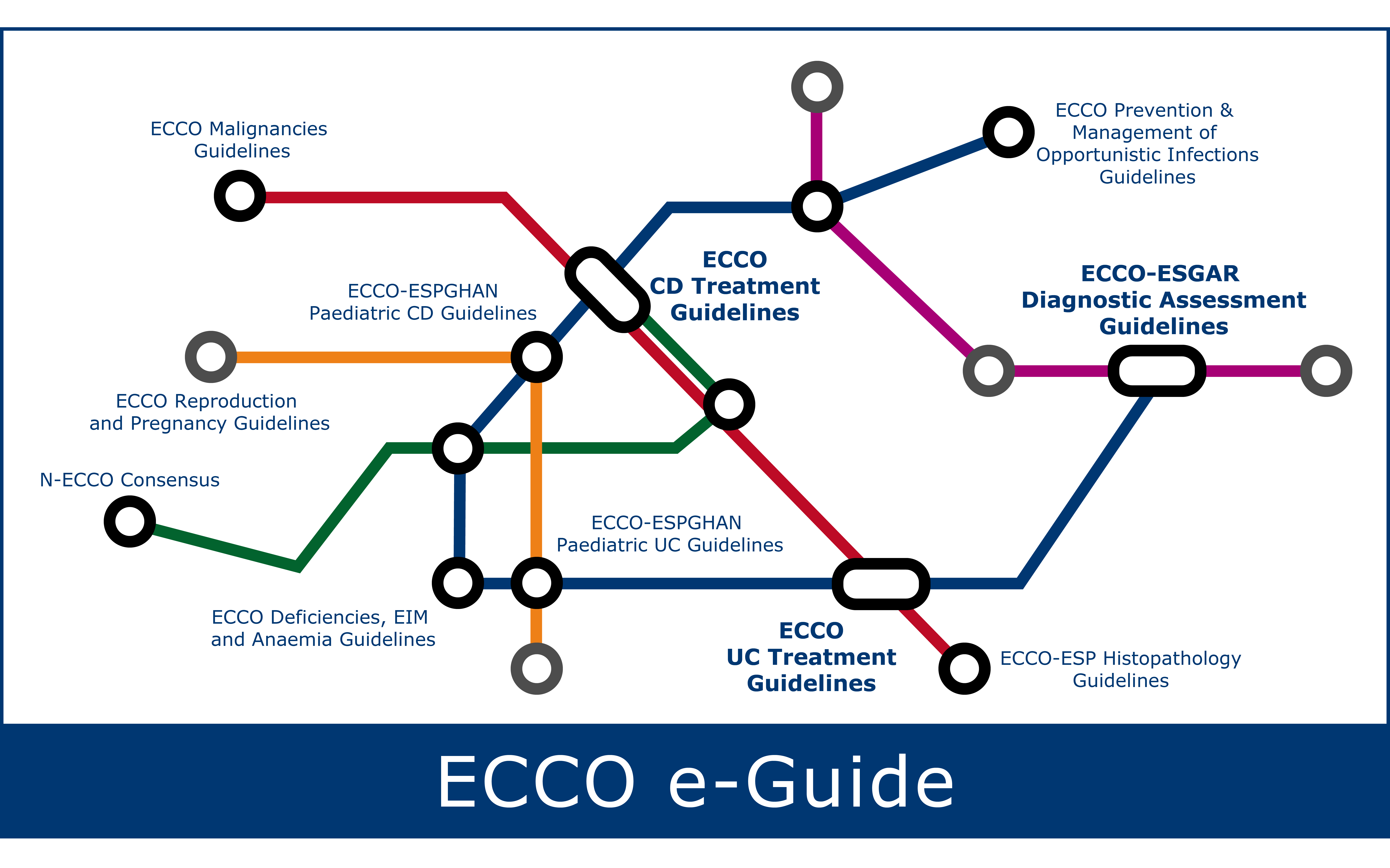The information below is based on the summary of product characteristics approved by regulatory authorities. For full details from the SmPC ,please click here: https://www.medicines.org.uk/emc/product/5133/smpc
Additional related ECCO e-Learning resources can be found under IBD Curriculum Topic 6.1-6.11
Introduction and Mechanism of Action
Golimumab is a human monoclonal antibody that forms high affinity, stable complexes with both the soluble and transmembrane bioactive forms of human TNF-α, which prevents the binding of TNF-α to its receptors. The binding of human TNF by golimumab was shown to neutralise TNF-α-induced cell-surface expression of the adhesion molecules E-selectin, vascular cell adhesion molecule (VCAM)-1 and intercellular adhesion molecule (ICAM)-1 by human endothelial cells. In vitro, TNF-induced secretion of interleukin (IL)-6, IL-8 and granulocyte-macrophage colony stimulating factor (GM-CSF) by human endothelial cells was also inhibited by golimumab.
Therapeutic indications
Golimumab is indicated for treatment of moderately to severely active ulcerative colitis in adult patients who have had an inadequate response to conventional therapy including corticosteroids and 6-mercaptopurine (6-MP) or azathioprine (AZA), or who are intolerant to or have medical contraindications for such therapies.
Dosing, administration
Patients with body weight less than 80 kg Golimumab given as an initial dose of 200 mg, followed by 100 mg at week 2.
Patients who have an adequate response should receive 50 mg at week 6 and every 4 weeks thereafter. Patients who have an inadequate response may benefit from continuing with 100 mg at week 6 and every 4 weeks thereafter (see section 5.1 of full SmPC).
Patients with body weight greater than or equal to 80 kg Golimumab given as an initial dose of 200 mg, followed by 100 mg at week 2, then 100 mg every 4 weeks, thereafter (see section 5.1 of full SmPC).
Contraindications
Hypersensitivity to the active substance or to any of the excipients listed in section 6.1 of full SmPC.
Active tuberculosis (TB) or other severe infections such as sepsis, and opportunistic infections (see section 4.4 of full SmPC).
Moderate or severe heart failure (NYHA class III/IV) (see section 4.4 of full SmPC).
Adverse effects
The most serious ARs that have been reported for golimumab include serious infections (including sepsis, pneumonia, TB, invasive fungal and opportunistic infections), demyelinating disorders, HBV reactivation, CHF, autoimmune processes (lupus-like syndrome), haematologic reactions, serious systemic hypersensitivity (including anaphylactic reaction), vasculitis, lymphoma and leukaemia (see section 4.4 of full SmPC).
ARs observed in clinical studies and reported from world-wide post-marketing use of golimumab are listed in the table below. Within the designated system organ classes, the ARs are listed under headings of frequency and using the following convention: very common (≥ 1/10); common (≥ 1/100 to < 1/10); uncommon (≥ 1/1,000 to < 1/100); rare (≥ 1/10,000 to < 1/1,000); very rare (< 1/10,000); not known (cannot be estimated from the available data).
Tabulated list of ARs
|
Infections and infestations |
|
|
Very common: |
Upper respiratory tract infection (nasopharyngitis, pharyngitis, laryngitis and rhinitis) |
|
Common: |
Bacterial infections (such as cellulitis), lower respiratory tract infection (such as pneumonia), viral infections (such as influenza and herpes), bronchitis, sinusitis, superficial fungal infections, abscess |
|
Uncommon: |
Sepsis including septic shock, pyelonephritis |
|
Rare: |
Tuberculosis, opportunistic infections (such as invasive fungal infections [histoplasmosis, coccidioidomycosis, pneumocytosis], bacterial, atypical mycobacterial infection and protozoal), hepatitis B reactivation, bacterial arthritis, infective bursitis |
|
Neoplasms, benign, malignant and unspecified |
|
|
Uncommon: |
Neoplasms (such as skin cancer, squamous cell carcinoma and melanocytic naevus) |
|
Rare: |
Lymphoma, leukaemia, melanoma, Merkel cell carcinoma |
|
Not known: |
Hepatosplenic T-cell lymphoma* |
|
Blood and lymphatic system disorders |
|
|
Common: |
Leukopenia (including neutropenia), anaemia |
|
Uncommon: |
Thrombocytopenia, pancytopenia |
|
Rare: |
Aplastic anaemia, agranulocytosis |
|
Immune system disorders |
|
|
Common: |
Allergic reactions (bronchospasm, hypersensitivity, urticaria), autoantibody positive |
|
Rare: |
Serious systemic hypersensitivity reactions (including anaphylactic reaction), vasculitis (systemic), sarcoidosis |
|
Endocrine disorders |
|
|
Uncommon: |
Thyroid disorder (such as hypothyroidism, hyperthyroidism and goitre) |
|
Metabolism and nutrition disorders |
|
|
Uncommon: |
Blood glucose increased, lipids increased |
|
Psychiatric disorders |
|
|
Common: |
Depression, insomnia |
|
Nervous system disorders |
|
|
Common: |
Dizziness, headache, paraesthesia |
|
Uncommon: |
Balance disorders |
|
Rare: |
Demyelinating disorders (central and peripheral), dysguesia |
|
Eye disorders |
|
|
Uncommon: |
Visual disorders (such as blurred vision and decreased visual acuity), conjunctivitis, eye allergy (such as pruritis and irritation) |
|
Cardiac disorders |
|
|
Uncommon: |
Arrhythmia, ischemic coronary artery disorders |
|
Rare: |
Congestive heart failure (new onset or worsening) |
|
Vascular disorders |
|
|
Common: |
Hypertension |
|
Uncommon: |
Thrombosis (such as deep venous and aortic), flushing |
|
Rare: |
Raynaud's phenomenon |
|
Respiratory, thoracic and mediastinal disorders |
|
|
Common: |
Asthma and related symptoms (such as wheezing and bronchial hyperactivity) |
|
Uncommon: |
Interstitial lung disease |
|
Gastrointestinal disorders |
|
|
Common: |
Dyspepsia, gastrointestinal and abdominal pain, nausea, gastrointestinal inflammatory disorders (such as gastritis and colitis), stomatitis |
|
Uncommon: |
Constipation, gastro-oesophageal reflux disease |
|
Hepatobiliary disorders |
|
|
Common: |
Alanine aminotransferase increased, aspartate aminotransferase increased |
|
Uncommon: |
Cholelithiasis, hepatic disorders |
|
Skin and subcutaneous tissue disorders |
|
|
Common: |
Pruritus, rash, alopecia, dermatitis |
|
Uncommon: |
Bullous skin reactions, psoriasis (new onset or worsening of pre-existing psoriasis, palmar/plantar and pustular), urticaria |
|
Rare: |
Lichenoid reactions, skin exfoliation, vasculitis (cutaneous) |
|
Musculoskeletal and connective tissue disorders |
|
|
Rare: |
Lupus-like syndrome |
|
Renal and urinary disorders |
|
|
Rare: |
Bladder disorders, renal disorders |
|
Reproductive system and breast disorders |
|
|
Uncommon: |
Breast disorders, menstrual disorders |
|
General disorders and administration site conditions |
|
|
Common: |
Pyrexia, asthenia, injection site reaction (such as injection site erythema, urticaria, induration, pain, bruising, pruritus, irritation and paraesthesia), chest discomfort |
|
Rare: |
Impaired healing |
|
Injury, poisoning and procedural complications |
|
|
Common: |
Bone fractures |
*: Observed with other TNF-blocking agents.
Interactions with other Drugs
No interaction studies have been performed.
The combination of golimumab with other biological therapeutics used to treat the same conditions as golimumab, including anakinra and abatacept is not recommended (see section 4.4 of full SmPC).
Live vaccines should not be given concurrently with golimumab (see sections 4.4 and 4.6 of full SmPC).
Therapeutic infectious agents should not be given concurrently with golimumab (see section 4.4 of full SmPC).
Special situations
Women of childbearing potential
Women of childbearing potential must use adequate contraception to prevent pregnancy and continue its use for at least 6 months after the last golimumab treatment.
Pregnancy
There are no adequate data on the use of golimumab in pregnant women. The use of golimumab in pregnant women is not recommended; golimumab should be given to a pregnant woman only if clearly needed. Golimumab crosses the placenta.
Breast-feeding
It is not known whether golimumab is excreted in human milk or absorbed systemically after ingestion.
Fertility
No animal fertility studies have been conducted with golimumab.

